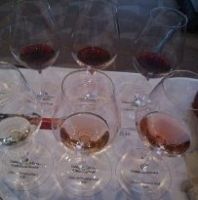Why Asia lacks pinkos


Cher Lim writes:
My husband was on a very specific mission this May when we visited Vinexpo in Hong Kong. He was determined to taste as many rosé wines as possible in preparation for his WSET L3 paper. The reason is we have a rather limited supply of rosé here in Singapore, a reflection of insufficient demand and importers who are not interested.
As we made our rounds in the exhibition area, we found ourselves, once again, hunting for the evasive pink wines as they were placed behind bottles of red and white wines, as if they were embarrassed to be seen. At each counter we visited, we would be offered anything but rosé, unless we asked. To some extent, this is déjà vu. Back here in Singapore, good-quality rosé wines are far too few. When I asked friends and colleagues what they think of rosé, it is either a non-committal reply or a straight negative answer.
So, what's the problem with rosé, especially when one would have thought that this great, refreshing wine is a perfect companion to our tropical weather? Possible reasons are:
- Most Asians (with majority Chinese) have a binary view of wine, it is either white or red. In actual fact, for many new wine drinkers, 'red wine' is synonymous with wine.
- It is widely accepted that red wine is the healthier choice of the wine family. Many consumers drink wine for its health benefits, so colour is an important attribute.
- There is no effort on the part of importers to educate the public on rosé. With such a lack of information, consumers automatically conclude that rosé is a diluted form of red wine, therefore it is of poorer quality. A self-fulfilling supply-demand cycle gives no further incentive for importers to bring in more rosé than they can sell.
- Male consumers treat rosé as a girlish drink. Female consumers are mainly attracted to rosé champagne, not rosé still wines.
As if reading my mind, a special session organised by Wines of Provence featuring rosé was available at Vinexpo HK. During this special session, which comprised a seminar cum tasting, several rosés were featured. The session turned out to be quite informative and interesting. I learnt that 88% of the wines produced by Provence are rosé. Most of them are consumed in France, which is a net importer of rosés. France is also the world's largest consumer of rosé wine. Rosés are typically inexpensive wines meant for enjoyment and the art de vivre. This may explain why producers are less motivated to market their wines in distant regions, although with the weak economic outlook in the EU, clearly there should be a change in the mindsets.
The three rosés featured were AOC Côte de Provence. They were characteristically pale, dry, aromatic and elegant. As Sacha Lichine, owner of Ch d'Esclans, said during his short introduction to his Whispering Angel rosé 2008, it is a wine that is refreshing, easy to drink, one you can imagine drinking on your boat… that is for those of you who have a boat. Yes if one can get Asian consumers to imagine the idyllic lifestyle of lazing in St Tropez drinking rosé on summer afternoons, perhaps the demand could surge!
Become a member to view this article and thousands more!
- 15,420 featured articles
- 274,421 wine reviews
- Maps from The World Atlas of Wine, 8th edition (RRP £50)
- The Oxford Companion to Wine, 5th edition (RRP £50)
- Members’ forum
- 15,420 featured articles
- 274,421 wine reviews
- Maps from The World Atlas of Wine, 8th edition (RRP £50)
- The Oxford Companion to Wine, 5th edition (RRP £50)
- Members’ forum
- Commercial use of our Tasting Notes